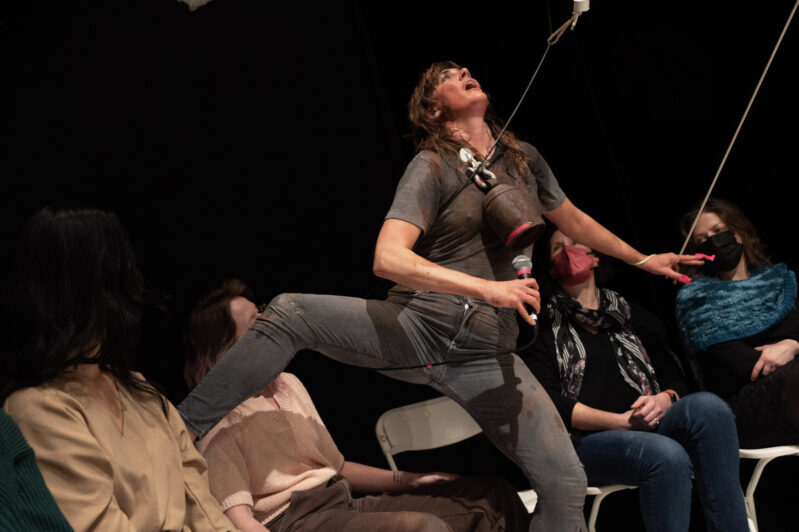The Tang of Lemon and Weight of Cinder Blocks
Review of Thank You For Coming: Space at On the Boards
Written by Teen Writer Daphne Bunker and edited by Kyle Gerstel

Before the show begins, sitting in the audience of Thank You For Coming: Space is like being surrounded by an immersive “I Spy” game. The stage is a white rectangle, with two rows of audience chairs around the perimeter, a raised set of tables on one end, and an opening in the seats on the other. Ropes crisscross in the air, tied to chair legs and slung high above on overhead bars. There’s a lemon suspended in the air, microphones, a bundle of leaves, and a bell too, all hanging over people’s heads as theatergoers trickle in from the lobby. A block of clay sits on a corner, and a pair of Doc Martens with wires duct taped to them lie resting on the floor.
Thank You For Coming: Space, created and performed by Faye Driscoll, is an experimental and participatory theater piece that seeks to explore the relationship between an artist and their audience. Driscoll begins the piece by walking into the space and speaking to the audience. What unfolds from there is an abstract, visceral, and deliberately constructed portrait of an artist’s inner thoughts.
Thank You For Coming: Space is indecipherable at times, but Driscoll grounds the piece with her earnest, committed performance. From her opening monologue, in which she thanks the audience for coming with a deteriorating smile and steady eye contact, to her desperate dance among sandbags and cinder blocks, to her final spoken word piece that’s simple yet quite literally gut-wrenching, she throws herself into every step, every line, and every emotion. The exact meaning of it all is impossible to pinpoint beneath the piece’s unabashed weirdness, but Driscoll still conveys the experience of an artist baring their soul to an audience, and she makes the piece feel wholly worthwhile through all the confusion.
The technical design of the piece, by visual designers Nick Vaughan and Jake Margolin, lighting designer Amanda K. Ringger, and sound designer Andrew Gilbert, also stands out as minimalistic yet inventive. The objects, hanging from ropes and lying on the stage, come into the piece one at a time and stay in view throughout the show. They create a strange sort of anticipation, left in plain sight to let the audience wonder how Driscoll will use them, and once they serve a purpose, they remain onstage as a memory of what happened before. The sound design is also innovative, whether looped whale songs that Driscoll groans into microphones or a crescendoing earsplitting feedback loop. The overhead lights, while the most minimal technical element, dim when the show’s pacing slows and brighten when it quickens, adding another valuable dimension to the technical design.
The whole of the piece is deeply abstract, but it is grounded by visceral sensory details. The first of the two sections of the show is a choreographed, mostly wordless interaction with the stage. This section is full of imagery, so distinct that audiences can feel like they are experiencing precisely what Driscoll is: the sour pulp of lemon in your mouth, the grinding weight of cinder blocks on your body, the texture of wet clay in your hands, or the pull of an audience member, holding tight to your hand as you lean your whole body away from them.
While these sensory elements make the show rich and interesting, there are some that are painfully overstimulating: at multiple points, massive sandbags drop to the floor and their impact booms through the theater; there are feedback loops that get louder and louder to an unbearable degree; and while Driscoll starts the show asking audience members to hold their hands, she eventually reaches a point where she grasps onto shoulders and knees without explicit consent. These moments follow the arc of the piece, but they could have easily been disclosed in the synopsis of the show so that theatergoers could be aware of these elements before buying tickets.
The second section of the show also helps ground the performance, distilling it into something quieter and even more thematically intense. Under a spotlight, Driscoll performs a spoken word piece, complete with more objects, lighting, and sound effects. It’s the most emotionally potent part of the show, bringing together the technical elements, sensory details, and Driscoll’s passionate performance in a format that is significantly more measured yet just as impassioned as the rest of the piece.
Sitting among the rest of the audience, within the bounds of the stage, listening to the final moments of Thank You For Coming: Space, I still didn’t know how to make sense of what Driscoll had performed for us. But there was something about the unapologetic abstractness of it that was so thoughtfully crafted, sitting somewhere between raw and ridiculous, that I couldn’t help but be transfixed.
Thank You For Coming: Space took place at On the Boards on January 19 - 22, 2023. For more information see here.
Lead Photo: Photo by © 2023 Bruce Clayton Tom.
The TeenTix Newsroom is a group of teen writers led by the Teen Editorial Staff. For each review, Newsroom writers work individually with a teen editor to polish their writing for publication. The Teen Editorial Staff is made up of 6 teens who curate the review portion of the TeenTix blog. More information about the Teen Editorial Staff can be found HERE.
The TeenTix Press Corps promotes critical thinking, communication, and information literacy through criticism and journalism practice for teens. For more information about the Press Corps program see HERE.


